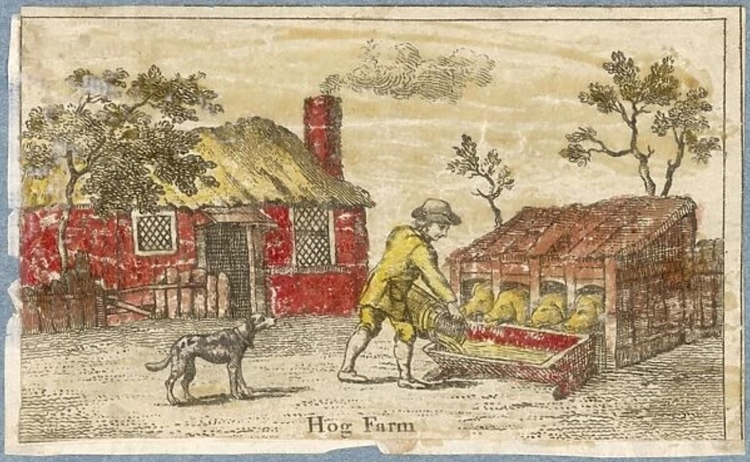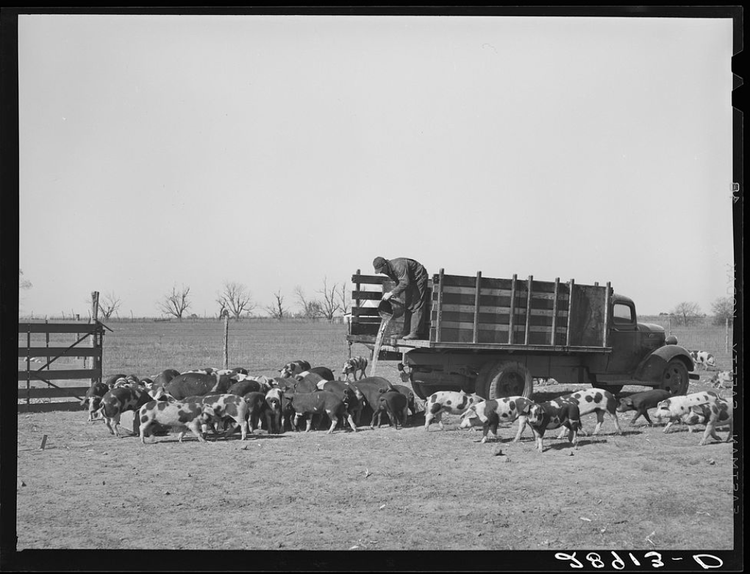Your basket is empty
Already have an account? Log in to check out faster.
Already have an account? Log in to check out faster.

On a July evening several months ago, as the heat of the long day was finally beginning to break and the still humidity became a cool breeze, I found myself cursing the name of a pig. A small and naughty gilt (young female pig) had gotten out of the fence because a tree limb had fallen on the electric wire, rendering our powerfully strong 10kV fence nothing but a string.
She never went far but it took hours and a team to get the defiant and strong-willed swine back where she belonged. Just before it went from dusk to total darkness, we had managed to get her into her paddock with her 29 friends. Exhausted, heading in for a dinner that I was hours late for, I asked myself, “Why did we chose to raise pigs?”
Their intelligence, strong will, and brute strength make them one of the more difficult animals to raise on pasture or woods, and that is only the beginning of the struggle of raising hogs. The contrast of the simplicity of raising grass-fed beef to raising pastured pigs is stark. With cows, it just works: cows eat grass; cows poop on grass; meat quality and land improve.
The complexity of hogs is that they like to eat what we like to eat— calorically dense, high protein foods with complete amino acid profiles. It’s a stark difference between what a hog thrives on versus a ruminant. It is very difficult to feed hogs exclusively off of one’s own land and even more of a challenge to do so at scale. This then begs the question, “What should we feed pigs?”
The ubiquitous answer to this question across the world today is corn and soy. Those two plants, within the past 150 years, have become the source of nutrition for 95% of the livestock raised in our country, the vast majority (92% of corn and 97% of soy) being genetically modified for resistance to glyphosate, otherwise known as Roundup (U.S. Department of Agriculture, 2023). When we think through the backbone of our food system that feeds the masses, everything from oils and sweeteners to meats and grains, the majority of it comes from these two plants. More than 50% of all calories consumed nationwide can be traced back to them. If there is any semblance of truth behind the phrase “you are what you eat”, Americans are corn and soy (Pollan, 2006).
Is it a bad thing to be made of? In short, I think yes. Aside from being genetically modified, both of these plants have an extremely high level of omega-6 to omega-3 ratio. A typical hog feed ration comprised of these plants has a 17:1 ratio, the ideal for human health being 2:1 (Nguyen, 2019). As the research done by Nguyen suggests, a “high omega-6: omega-3 ratio in diets promotes the pathogenesis of many diseases, including cardiovascular disease, cancer, and inflammatory and autoimmune diseases.” Not to mention high blood pressure, insulin resistance & pre-diabetes, allergies, Alzheimer’s and most chronic inflammatory diseases pointed out by other research (Patterson, 2012 & Hu, 2013). Unfortunately, feeding the organic version of these products does not absolve one from this issue, though it is superior in many other regards.

All the formulated rations for animal feeds (both organic and conventional) are essentially combinations of these two plants in different proportions. This however, is not the historic norm. The American settlers were not going to Tractor Supply to buy a bag of mixed mush to give their backyard pigs— the concept would be perplexing actually. Before the advent of the tractor, grain was precious and cultivated almost exclusively for human consumption. When you consider the tilling, planting, cultivating and harvesting that went into growing grain preindustrialization, you understand why it was so foreign to feed that precious crop to animals. The animals ate the stuff that grew by itself, grass being a great example. Yet this doesn’t answer the question: What of this sort went to the pigs if they can’t live off of just grass?
On top of the tree mast (acorns, hickory nuts, chestnuts, etc.) that they foraged along with other forages that they acquired, pigs ate what we didn’t eat. Hogs are the waste up-cyclers of the farm. A pig 200 years ago on the American homestead would have gotten milk byproducts, discarded vegetables and the hulls of the grains that were milled, but they certainly were not fed milled and roasted corn and soy beans.
As a producer of organic pork who has forfeited the ease of feeding the two things the entire world raises pigs on, we are constantly figuring out what it means to raise pigs in a way that our great grandchildren can look back on in 100 years and think “At least they did that right”. This has meant reevaluating what a pig ought to eat while also gaining weight at the rate we need them to in order to be profitable. A sustainable pig is one who eats the food that is on its way to the landfill— who takes our excess and turns it into meat and fat. The same way the cow fills the niche of turning grass into meat, pigs do the same thing with “waste”.
However, with the massive supply chain that we now have, our waste streams are not so simple. We are excellent at throwing stuff out. Through our modern systems in place, we have made it very easy for ourselves to take what we don’t want, put it in the bin and the magical fairies just take it to the land known as “away”. The infrastructure and trucks are so sophisticated that it seems like what we do with it must be as well. In all of our innovative brilliance, this system is a complex way of making a big pile of garbage in a location we declare hospitable. Then follows the million year process of breaking down plastics and food that won’t compost because of the sterile environment created by the variety of petrochemicals that end up in these piles.

Another obstacle for us in thinking about how our a farm can serve as an up-cycler from waste to food is the purity and health of our products, given that 98% of the food waste in this country is not something we want to feed to our pigs. These hog are organic and we’ve gone through great lengths to make sure they stay that way. Thus, we also forfeit the common practice of going to any grocery or restaurant with bins and saying “fill us up”.
The other side of this is cost— we have been spending a fortune purchasing organically and locally grown corn-free and soy-free feed for our hogs. All things considered, we’re left with three options: feed a cheaper feed with corn or soy in it (no way), increase our prices, or find creative ways to lower our cost of production. We’ve gone with the third option, as we hunt for waste streams that are organic, locally produced and have the ideal omega-6 to omega-3 ratio that we so adamantly feel our pork must have to make it the health product it is.
The most recent centerpiece of our current solution has been whey from local, organic, and 100% grass-fed cows. This whey contains a complete protein profile along with sugars and fat from the milk. Whey is the by-product of yogurt and cheese making. Our hogs have been absolutely loving it and so has our business. This is a very new addition to our operation and we will keep you updated through this newsletter and our social media as we learn more and continue to pursue more avenues such as these.
On top of choosing to raise pigs because, frankly, I couldn’t find anyone in our region raising the pork I wanted to eat, I suppose this is why we raise hogs: not because it is easy but because it is hard. Additionally, we’re striving to create an enterprise that is unique in its traditionalism. An extremely common farm model in the pre-WWII northeast was a small, grass based dairy that sold its cream for butter, who then raised hogs on their skim milk. It was simple, it worked, and it fed a growing nation.
To many on the outside, farms are perceived as these stagnant operations that put x in and get y out, have done it this way for a long time, and will continue to do so. Although this may be true for some, in my personal experience among the farmers I know and respect, it couldn’t be further from the truth. A farm is a piece of artwork with which the painter will never put his brush down. A good farm is constantly evolving, examining and asking why, then taking action to improve on the answers, adding more color, texture and life to the work.
We may not get out much, but we’re never bored, and the farm is never mundane. Words cannot express our gratitude to you as you support us and walk with us as we keep painting on this canvas we call Northaven Pastures.
If you ever have any questions, want to chat, or are interested in seeing our operation first hand, please don’t hesitate to give us a call or drop us an email!
Bennett & the Northaven Pastures team